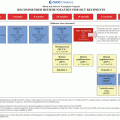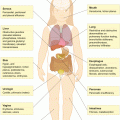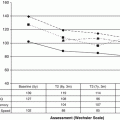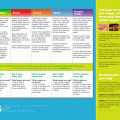© Springer New York 2015
Grace A. Mucci and Lilibeth R. Torno (eds.)Handbook of Long Term Care of The Childhood Cancer SurvivorSpecialty Topics in Pediatric Neuropsychology10.1007/978-1-4899-7584-3_33. The European Experience of Establishing Guidelines for Surveillance of the Childhood Cancer Survivor
(1)
Department of Paediatric and Adolescent Haematology and Oncology, Children’s BMT Unit, Great North Children’s Hospital (Royal Victoria Infirmary), Newcastle upon Tyne, NE1 4LP, UK
(2)
Scientific Coordinator of the Long Term Follow Up Clinic Istituto. Giannina Gaslini, 16147 Genoa, Italy
(3)
Department of Paediatrics, Skåne University Hospital, Clinical Sciences, Lund University, 221 85 Lund, Sweden
(4)
Department of Pediatric Oncology, Emma Children’s Hospital/Academic Medical Center, Meibergdreef 9, 1105 Amsterdam, The Netherlands
Keywords
European guidelinesInternational harmonization of long term follow-up guidelines3.1 Introduction
Continuing improvements in the treatment of childhood cancer have been observed across developed regions of the world during the last 50 years. However variations in survival persist between the different European regions. The Automated Childhood Cancer Information System (ACCIS) pooled data from most of the European population-based cancer registries and demonstrated that the improvements in 5- and 10-year probability of survival after a diagnosis of childhood cancer have been greater for children treated in Northern and Western Europe, or in the British Islands, than for those treated in Eastern or Southern Europe [1]. These differences in regional outcomes may reflect variations in access to medical care and in healthcare systems.
However, the gap between Eastern and Southern Europe and the other regions of the continent fell in magnitude during the 20 years covered by that study, and it is therefore reasonable to believe that in the coming decades survival rates close to 80 % will be observed in most children with newly diagnosed cancer in Europe [2].
There is no official aggregate data collection about the number of childhood cancer survivors (CCS) living in Europe, but there is some information from population-based national cancer registries such as those from the U.K. and the Nordic countries. For example, a Nordic study has estimated that 1 in every 1,000 individuals in the general population is a survivor of childhood cancer [3]. This figure might differ between European countries due to the above-mentioned differences in survival rates across Europe over time. Nevertheless, it is reasonable to estimate that there are now 300,000–500,000 CCS living in Europe. With a population of about 488 million inhabitants across the 27 European Union (EU) countries and assuming that 16 % are aged between 0 and 14 years, there are about 78.2 million children in Europe. Given an estimated average childhood cancer incidence in Europe of about 141 new cases/million/year [4], each year about 11,000 new childhood cancer cases will be diagnosed in the continent, and if a conservative overall 5 year survival of 75 % is assumed for these children over the next few years, it can be calculated that each year the European population of long-term CCS will increase by about 8,250.
At the same time that it is increasing in size, the population of CCS is also increasing in attained age and a significant number have reached or are entering adulthood. It is now estimated that the median age of CCS is between 20 and 29 years (depending on the country) with some of the oldest survivors already well beyond their 50th birthday. For example, data collected by the U.K. National Registry of Childhood Tumours since 1962 demonstrates that while in 2005 there were 25,989 CCS in the UK, with a median age between 20 and 24 years, in 2009 there were 30,174 survivors (a mean annual increase of about 1,000 survivors) with an older median age of 25–29 years (Stiller CA, personal communication, with permission).
Over the last three decades, increasing awareness has emerged amongst healthcare providers, as well as survivors and their families, that successful cancer treatment may cause late adverse effects in CCS, and in particular among those treated during childhood when the body is still developing. Moreover, it becomes evident that the national health systems in general and the pediatric cancer centers in particular need additional resources to address the emerging needs of survivors related to side effects of their previous treatment, and that transition programs need to be developed for CCS entering adulthood.
In 2008, PanCare (the Pan-European Network for Care of Survivors after Childhood and Adolescent Cancer) was founded in Lund, Sweden by a group of clinicians and epidemiologists with the ultimate aim of ensuring that every European survivor of childhood and adolescent cancer receives optimal long-term care. Subsequently, the network has grown to include more than 150 individuals including pediatric oncologists and hematologists, radiotherapists, other pediatric and adult medical sub-specialists, psychologists and nurses. It also now represents survivors and their families.
Recently, PanCare members were funded by the European Union (EU) to develop PanCareSurFup (PanCare Childhood and Adolescent Cancer Survivor Care and Follow-Up Studies) (www.pancaresurfup.eu), a project to undertake detailed large-scale epidemiological studies of late mortality and of risk factors for severe cardiovascular events and second malignant tumours, and which also has the ambitious objective to develop pan-European guidelines for long-term follow-up (LTFU) of CCS. This will include detailed recommendations for follow-up based on the treatment previously received, for models of care to facilitate LTFU and transition to adult care, and finally for promotion of optimal future health of survivors.
3.2 Clinical Practice Guidelines
The main aim of clinical practice guidelines is to improve healthcare processes and health outcomes. Their effective implementation will promote consistency in daily clinical practice and hence facilitate optimal utilization of healthcare resources. They are increasingly being used to assist both clinical and healthcare policy decision-making [5]. As defined by the US Institute of Medicine, clinical practice guidelines are “statements that include recommendations intended to optimize patient care that are informed by a systematic review of evidence and an assessment of the benefits and harms of alternative care options” [6]. Guidelines are viewed as powerful tools to improve the quality of care. They can contribute to decreased variability in healthcare decisions between physicians, and stimulate effective care, communication and collaboration between different healthcare professionals, as well as between healthcare professionals and patients.
Before the wider use of guidelines, clinical practice was usually guided by non-systematic observations based on clinical experience. The knowledge of basic disease mechanisms and pathophysiology was considered sufficient to guide clinical decision-making [7]. Systematic development of guidelines within a well-defined program started in the late 1970s. Guidelines were seen as tools to improve the quality of care, and were mainly consensus-based. The U.S. National Institutes of Health initiated the development of these so-called “consensus statements.” The consensus conference had a central role within this process [8]. During the 1980s, various other organizations outside the USA adopted this program to develop their own consensus statements and standards for good medical care.
In the early 1990s, a shift emerged to more evidence-based clinical practice based on content-expertise and clinical experience-based decision-making. In 1992 evidence-based medicine (EBM) was introduced by the EBM Working Group. EBM is the process of integrating clinical expertise with the best research evidence to make high-quality decisions about the care of individual patients (Evidence-Based Medicine Working Group 1992). This emphasized the importance of systematic literature searches and evidence summaries in the development of guidelines. The Cochrane Collaboration was founded in 1993 to improve the availability of the best evidence in healthcare by facilitating the preparation and maintenance of systematic reviews. Cochrane systematic reviews help clinicians evaluate all the evidence addressing a particular clinical problem, using standardized methodology for searching and appraising the literature and for reporting the results [9].
In 1996 the second fundamental principle of EBM was presented. This principle suggested that decision makers must always balance the benefits and risks, inconvenience and costs associated with alternative management strategies in the decision making process, and also include consideration of the patients’ values [10, 11].
The principles of EBM dominate contemporary guideline programs. The method of evidence-based guideline development has become the international standard by which contemporary clinical practice guidelines should integrate the best available evidence and clinical judgment, as well as the patients’ perspectives.
3.3 Potential Advantages of Guidelines
Guidelines are a combination of a summary of evidence-based knowledge and recommendations. It is very challenging for a healthcare professional to remain up-to-date since more than two million new scientific papers are published each year. There is far too much information available and the conclusions of published work may be conflicting since all the accessible information is rarely summarized. Guidelines can facilitate in bridging the gap between research and clinical practice.
Clinical practice guidelines can improve the quality of clinical decisions. They are useful for clinicians who are uncertain about how to proceed, and also enable the patient to make well- informed healthcare decisions and to consider their personal needs and preferences in selecting the best option [5].
The greatest potential benefit of guidelines is the improvement of health outcomes. Guidelines recommending proven effective interventions and discouraging ineffective ones may reduce morbidity and mortality, and thus improve quality of life. Guidelines also make it more likely that patients receive uniform high-quality care, thereby reducing variability in daily healthcare practice. It has been shown that the consistency of healthcare is low—the frequency with which procedures are performed varies considerably between clinicians and geographical regions [5, 12]. Several international reviews have shown that the majority of implemented guidelines have resulted in significant improvements in the process and structure of care [13–15].
Finally, clinical practice guidelines can contribute to reduced healthcare costs by standardizing care and hence increasing the efficiency of care provision and reducing unnecessary or inefficient components of healthcare. Guidelines reduce expenses for hospitalization, drug prescriptions, surgery, and other procedures [5].
3.4 Evidence Based Guidelines
Many clinical practice guidelines have been developed by expert groups without complete appraisal of the evidence. This method relies on the group’s knowledge of existing evidence and the clinical experience of its members. However, the knowledge of clinicians of published work is often incomplete due to poor presentation and dissemination of research findings and difficulties to keep fully up-to-date with the published literature. Guidelines developed without formal literature reviews and critical appraisal of the evidence may be biased towards supporting current practice rather than promoting newer and more evidence-based practice [16].
Traditionally, the incorporation of evidence into guideline development was achieved by providing narrative reviews of topic areas by experts in the field. However, the general methodology of this type of review is not transparent, since there are no explicit research strategies and inclusion criteria, and formal methods of synthesizing the evidence are lacking. Authors may cite studies selectively supporting their own opinion and fail to cite other studies providing alternative evidence. Therefore guidelines developed after non-systematic literature reviews may be prone to selection bias and provide false reassurance [16].
Evidence-based guidelines attempt to be as complete and focused as possible in summarizing the available evidence. The best way to summarize the evidence is a systematic review. However, since this is very time consuming and costly, a decision should be taken during the guideline process for which particular issues a systematic review should be performed. A systematic review aims to minimize the occurrence of bias through an explicit search strategy to identify all available evidence, selection and assessment of the methodological quality of the evidence, and reduction of random error by using quantitative methods (i.e., meta-analysis). The Cochrane Collaboration is the largest provider of systematic reviews for healthcare and includes approximately 6,000 systematic reviews in the Cochrane Library. The Cochrane Collaboration developed standardized methods to perform systematic reviews. The Cochrane Childhood Cancer Group (CCCG) in Amsterdam has been registered within the Cochrane Collaboration since 2006 (www.ccg.cochrane.org). The goal of the CCCG is to conduct and maintain systematic reviews on diagnosis of and interventions for cancer in children and young adults with respect to prevention, treatment, supportive care, psychosocial care, palliative and terminal care, nursing care, and late adverse effects of treatment.
However the translation of evidence into recommendations is not always straightforward since data can be interpreted in different ways depending on clinical experiences. In addition, one should keep in mind that evidence is only one component of the development of evidence-based guidelines and needs to be considered alongside clinical expertise and patient values. Transparency about the process is essential [9, 16].
3.5 General Methods for Guideline Development
To ensure that guidelines can be effective in improving healthcare they should meet specific quality criteria. Preferably, guidelines should be developed within a structured and coordinated guidelines program. The guideline process consists of the following steps:
1.








